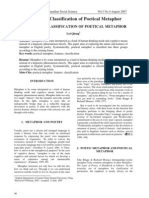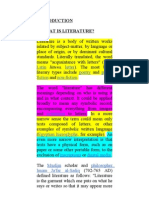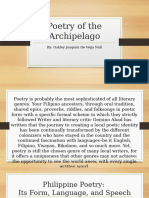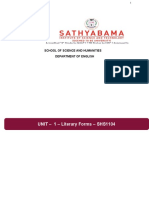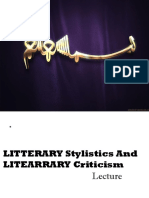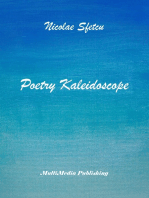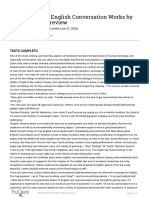One Art by Elizabeth Bishop
One Art by Elizabeth Bishop
Uploaded by
MARIA FRANCHESKA PLATONCopyright:
Available Formats
One Art by Elizabeth Bishop
One Art by Elizabeth Bishop
Uploaded by
MARIA FRANCHESKA PLATONCopyright
Available Formats
Share this document
Did you find this document useful?
Is this content inappropriate?
Copyright:
Available Formats
One Art by Elizabeth Bishop
One Art by Elizabeth Bishop
Uploaded by
MARIA FRANCHESKA PLATONCopyright:
Available Formats
Stylistic Approach to Elizabeth Bishop's Poem "One Art”
Kyla Ann Bayani; Christine Nathalie Gamez, and Maria Francheska Platon.
Batangas State University-The National Engineering University ARASOF Campus
mariafrancheskaplaton@gmail.com
ABSTRACT
Elizabeth Bishop's poem "One Art" explores the theme of loss and its significance in shaping human
resilience. This study aims to analyze Bishop's language and stylistic choices to better understand the poem's
thematic focus. Employing stylistic analysis, the study discloses how Bishop's word selection contributes to the
exploration of loss and acceptance depicted in the poem. Additionally, the exploration focuses on the
graphological, phonological, syntactic, and semantic elements present in the poem. By examining these levels,
the research reveals the interplay between form and content, sound and meaning, structure and emotion.
Synthesizing insights from these analyses, this study provides a holistic interpretation of Elizabeth Bishop's
"One Art," shedding light on its significance as a reflection on the human experience of loss and the enduring
power of acceptance.
Keywords: Stylistics, graphological level, phonological level, syntactic level, verbal group, lexical
collocation, semantic analysis
"One Art," Bishop's quintessential
1. INTRODUCTION villanelle, talks about how we deal with losing
things. The poem mentions a range of losses, from
Poetry is widely acknowledged as the items like keys and watches to significant aspects
language of the soul, which has a distinct capacity such as cherished possessions and relationships.
to evoke emotions, stimulate reflections, and But through all these losses, the poem shows how
outline human experiences within its verses. Poets, people can cope and keep going, showing how
through their thoroughly selected words, create strong and adaptable we can be when faced with
vivid emotional pictures that deal with life's life's changes.
challenges, as noted by Nair (2023). Elizabeth
Bishop emerges as one of these respected literary In Elizabeth Bishop's "One Art," the
figures, whose works deeply connect with theme of loss and the difficulty of acceptance are
audiences across different generations. Her well- thoroughly examined. Despite its complications,
known poem "One Art" is a touching look at loss, the poem serves as a platform for contemplation
strength, and the fragile skill of accepting things as on sadness and resilience. Readers gain a deep
they are, offering a deep understanding of what it understanding of language and emotions, finding
means to be human. comfort and realizations within Bishop's verses.
Within the exploration of Rathbun (2019),
Elizabeth Bishop's mastery of language and acute 2. DEFINITION OF TERMS
observations infuse her poetry with rare
authenticity and depth. Born in 1911, her life was Stylistics is the study of styles,
marked by various losses, including the early particularly in literature. As per Dr. Aminu
deaths of her father and mother. These experiences (2015), stylistic looks closely at how language
deeply influenced her poetic sensibilities, as did is used in different ways, especially in literary
her nomadic lifestyle, characterized by travels works like poems or stories. It is a part of
across continents in search of home and belonging. linguistics because it focuses on how language
This supported the study of Meniado et al. (2016) is used creatively. Also, it's about
in Bishop's Life, which stated that she lived and understanding how language choices affect the
traveled in several countries, including North way we read and understand texts. Moreover,
Africa, France, Italy, and Spain. It was where she according Giovanelli (2018), stylistics is a
composed several poems inspired by her love of branch of linguistics, which means it's a
travel. Her travel poetry was deemed specific way of using language knowledge,
contemplative—reflecting on her experiences, like sociolinguistics (looking at language in
feelings, what's at risk in her excursions, and her social contexts) or psycholinguistics
learnings about life as she immersed herself in a (exploring how the mind processes language).
new place. The main idea behind stylistics is that
whenever individual speak or write, they’re
always making choices about the words use
(lexical choices) and how they organize them lovely ones," serve as leitmotifs. These
(syntactic structure), whether they realize it or refrains drill the poem's core message into the
not. These choices create a unique style, and reader’s consciousness, showcasing loss as an
altering them changes that style. Stylistics inevitable, albeit manageable, facet of the
provides a balanced approach, letting human experience. The strategic use of
individual interpret a text while closely enjambment propels the poem forward,
examining the language to back up analysis. mirroring the unpredictable and continuous
nature of loss. By extending thoughts beyond
2.1. Level of Stylistic the confines of line breaks, Bishop simulates
the fluidity and abrupt shifts that characterize
The following are the levels of stylistics. We personal and existential losses.
analyze the text according to these levels. Bishop's sparing use of commas and
1. Graphological level- Refers to the visual periods bestows the poem with a
aspects of a text, such as font, layout, and conversational, almost stream-of-
punctuation, which contribute to its consciousness tone. This minimal punctuation
meaning. strategy invites readers into a more intimate
2. Phonological level- Level- refers to how and open-ended engagement with the text,
sound is organized to mean. Sound allowing for personal interpretation and
patterning functions linguistically in emotional resonance.
poetry to project a poet’s purpose or The poem predominantly relies on an
concern in a work iambic meter, establishing a rhythmic stability
3. Syntactic level- This has to do with the that contrasts with the turmoil of loss. This
arrangement of units larger than the word. regular beat, especially in lines like "The art
These units include groups/phrases, of losing isn't hard to master," offers a
clauses, and sentences. comforting backbone to the poem's
4. Verbal group- A group of words that exploration of loss.
function together as a unit within a In specific instances, such as "So many
sentence, often consisting of a main verb things seem filled with the intent," Bishop
and its accompanying words or modifiers. shifts to a trochaic meter, emphasizing key
5. Lexical Collocation- The habitual pairing ideas and enhancing the poem's emotional
or grouping of words together due to their texture. The use of caesura, as seen in "Lose
frequent co-occurrence in a language, something every day. Accept the fluster,"
contributing to the overall meaning and introduces a pause that heightens the
style of a text. significance of the ensuing advice, reflecting
6. Semantic analysis- The examination of the jarring moments of realization that
meaning in language, focusing on how accompany loss.
words, phrases, and sentences convey The poem's use of "I" and "you"
intended messages or concepts. personalizes the experience of loss, moving
from the abstract to the specific. Lines like "I
3. GRAPHOLOGICAL ANALYSIS lost two cities, lovely ones. And, vaster," draw
Graphological analysis involves readers into the speaker's personal sphere,
examining the physical aspects of a text, such revealing the depth and breadth of their losses,
as its layout, structure, and punctuation, to while also making the universal theme of loss
gain insights into its meaning and emotional intimate and relatable.
impact. To enhance the analysis of the The repetition of key phrases (anaphora)
graphological elements in "One Art" by and the detailed enumeration of losses (e.g.,
Elizabeth Bishop, consider the following "lost door keys, the hour badly spent") enrich
refined observations: structure, repetition, the poem's texture. These techniques not only
enjambment, punctuation, iambic meter, underscore the pervasiveness of loss but also
trochaic meter and caesura, personal its particularity in each person's life, making
pronouns, anaphora and specificity: the abstract concept tangibly personal. By
The poem meticulously adheres to the refining the analysis of these graphological
villanelle form, weaving a tight fabric of five elements, we gain deeper insights into how
tercets followed by a concluding quatrain. "One Art" by Elizabeth Bishop masterfully
This rigorous structure juxtaposes the theme conveys the complexity of loss through its
of uncontrollable loss, presenting an intriguing form and language, blending structure with
contrast between the desire for order and the fluidity, and personal vulnerability with a
chaos of losing. Essential to the villanelle's universal theme.
charm, the recurrent lines "The art of losing
isn't hard to master" and "I lost two cities,
4. PHONOLOGICAL ANALYSIS "l" and "v" sounds in "love," "lied," and
"evident" convey sincerity and clarity, enhancing
Phonological analysis search into the the emotional depth. "the art of losing's not too
sound sequences and their characteristics within a hard to master" merges trochaic and iambic feet.
poem. Consider the line, "The art of losing isn't
hard to master." It opens with a trochaic foot, The contraction in "losing's" introduces a
marking a stressed-unstressed pattern, yet open out conversational, intimate tone. The "s" and "t"
into a predominantly iambic meter as it progresses. sounds in "losing's," "not," "too," and "master"
underscore the poem's resolution and emphasis.
The line is sonically enriched by the "though it may look like (Write it!) like a
continuant in "losing," "isn't," and "master," disaster" is structured with trochaic and iambic
lending a soft, breathe quality. In the line "So feet. The parenthetical "Write it!" breaks the flow,
many things seem filled with the intent," we underlining the directive's urgency. The "l" and
notice the anapestic foot (unstressed-unstressed- "k" sounds in "look," "like," and "disaster" infuse
stressed) leading into an iambic pattern, creating a the line with a sense of doubt and ambiguity.
rhythmic momentum. The alliteration of "s" and
"m" in "so many," "seem," and "filled" The intricate use of various metrical
construct a smooth, flowing sounds. "To be lost patterns and recurring sounds throughout the poem
that their loss is no disaster" combines trochaic not only enriches its rhythmic quality, tone, and
and iambic meters, enhancing the poem's rhythmic emotional appeal but also foregrounds the
diversity. The repetition of "l" and "s" in "lost," recurring theme of loss and the resilience in
"loss," and "disaster" not only emphasizes the confronting it.
poem's thematic focus on loss but also creates a
4.1 RHYME SCHEME
link across the lines, echoing the central theme.
"Lose something every day. Accept the fluster" A rhyme scheme is the pattern of sounds
introduces a mix of trochaic and anapestic feet, at the end of each line in a poem. It is usually
injecting a sense of movement and slight disarray, described using letters to represent the sounds that
reflected in the repeated "s" and "f" sounds in rhyme with each other. For instance, in an ABAB
"lose," "something," "accept," and "fluster." rhyme scheme, the first and third lines rhyme with
The line "of lost door keys, the hour badly spent" each other, and the second and fourth lines rhyme
employs both iambic and trochaic meters. The "d" with each other. Identifying the rhyme scheme
and "s" sounds in "door," "keys," "badly," and helps understand the poem's structure and how the
"spent" are accentuated, underlining the theme of poet creates rhythm and emphasis.
loss with added vigor.
“One Art”
As the poem revisits "The art of losing By Elizabeth Bishop
isn't hard to master," the repetition reaffirms the
phonological patterns observed initially, sustaining The art of losing isn’t hard to master; A
the poem's cohesive sound structure. "I lost two so many things seem filled with the intent B
cities, lovely ones. And, vaster" starts with a to be lost that their loss is no disaster. A
trochaic foot and blends iambic and anapestic
meters. The "l" and "v" sounds in "lost," Lose something every day. Accept the fluster A
"cities," "lovely," and "vaster" evoke a sense of of lost door keys, the hour badly spent. A
grandeur and deep longing. "Some realms I The art of losing isn’t hard to master. A
owned, two rivers, a continent" showcases
trochaic and iambic feet. The "r" and "m" sounds Then practice losing farther, losing faster: A
in "realms," "rivers," and "continent" broaden places, and names, and where it was you meant B
the poem's sonic landscape, suggesting vastness to travel. None of these will bring disaster. A
and expansiveness. "I miss them, but it wasn't a
disaster" combines trochaic and iambic meters. I lost my mother’s watch. And look! my last, or A
The "m" and "s" sounds in "miss," "them," next-to-last, of three loved houses went. B
"wasn't," and "disaster" imbue the line with a The art of losing isn’t hard to master. A
tone of wistfulness and subdued acceptance. "—
Even losing you (the joking voice, a gesture" I lost two cities, lovely ones. And, vaster A,
begins with a trochaic foot and transitions to an some realms I owned, two rivers, a continent. B
iambic pattern. The inclusion of a parenthetical I miss them, but it wasn’t a disaster. A
phrase disrupts the rhythm, spotlighting the loss's
weight. The "g" and "v" sounds in "losing," —Even losing you (the joking voice, a gesture A
"gesture," and "even" add a layer of emphasis I love) I shan’t have lied. It’s evident B
and immediacy. "I love) I shan't have lied. It's the art of losing’s not too hard to master A
evident:" combines anapestic and iambic feet. The though it may look like (Write it!) like disaster. A
The Bishop’s poem consists of six (6) sixteen (16) rhymes with “evident” in line eighteen
tercets followed by a concluding quatrain, (18). The concluding lines “gesture” in line
summing up to a total of nineteen (19) lines. In this nineteen (19) and “master” in line twenty-one (21)
poetic arrangement, Bishop employs a villanelle lead to the final “disaster” in line twenty-two (22),
structure with a distinctive rhyme scheme of ABA bringing the poem full circle and emphasizing the
ABA ABA ABA ABA ABAA pattern. The tension between mastering loss and the emotional
repeated refrains and alternating rhyme scheme impact it carries.
contribute to the poem’s meditative quality,
emphasizing the theme of loss and mastery Bishop’s use of rhyme creates a cohesive
throughout the poem. narrative about loss, suggesting that while the art
of losing can be learned, it often remains deeply
4.2. RHYME emotional. The rhymes enrich the poem's
musicality and underscore its contemplative tone.
Line Number End Rhyme 4.3 ASSONANCE
1, 3 master – disaster Assonance is the repetition of vowel
2, 5 intent – spent sounds within words. Bishop’s use of assonance
4, 6 fluster – master adds to the musicality and flow of the poem. Here
7, 9 faster – disaster are the examples of the assonance in the poem:
8, 10 meant – went "The art of losing isn’t hard to master"
"Even losing you (the joking voice, a gesture I
11, 13 last, or – master
love)"
12, 14 went – continent The repetition of the short "i" sound in "isn’t" and
15, 17 vaster – disaster "is" and the long "o" sound in "losing" and
16, 18 continent – evident "gesture" helps to create internal rhymes that
19, 21 gesture – master contribute to the poem's melodic quality.
20, 22 evident – disaster
In the opening tercet (ABA), Bishop 4.4 CONSONANCE
creates a sense of symmetry. She pairs “master” in Consonance is the repetition of consonant
line one (1) with “disaster” in line three (3), both sounds, particularly at the end of words. In "One
using the '-er' sound, and follows with “intent” in Art," Bishop uses consonance to create a rhythm
line two (2) and “spent” in line five (5), creating a and cohesion within the poem. Examples of the
pattern that echoes throughout the poem. consonance in the poem are:
"The art of losing isn’t hard to master"
Moving to the second tercet (ABA), the "their loss is no disaster"
poem continues its rhyming pattern with new end In these lines, the repetition of the "s" sound ties
rhymes. Here, “fluster” in line four (4) pairs with the concepts of "losing," "isn’t," "loss," and
“master” in line six (6), reinforcing the central "disaster" together, creating a sense of continuity.
theme. This stanza encourages acceptance of
everyday losses. 5. GRAMMATICAL/SYNTACTICE
FEATURES
In the third tercet (ABA), Bishop
maintains the rhyming structure with another set of Elizabeth Bishop's poem "One Art"
end rhymes. “Faster” in line seven (7) rhymes demonstrates several typical grammatical and
with “disaster” in line nine (9), while “meant” in syntactic features found in poetry. Written in
line eight (8) and “went” in line ten (10) continue villanelle form with a strict structure of 19 lines
the pattern, highlighting how we deal with and a repeated rhyme scheme, the poem utilizes
significant personal losses. repetition, particularly emphasizing the theme of
loss and acceptance. Furthermore, Bishop employs
The fourth tercet (ABA) pairs “last, or” enjambment to create smoothness and forward
in line eleven (11) with “master” in line thirteen movement, guiding the reader through the
(13) and “went” in line twelve (12) with narrative. For example, in the lines "Then practice
“continent” in line fourteen (14). This set of losing farther, losing faster: places, names, and
rhymes illustrates that even substantial losses, like where it was you meant," the thought continues
houses or entire continents, are part of the art of seamlessly from one line to the next without
losing. interruption, enhancing the poem's rhythm and
conveying a sense of inevitability in the process of
In the final tercet and quatrain (ABA), losing.
“vaster” in line fifteen (15) rhymes with “disaster”
in line seventeen (17), and “continent” in line
Moreover, the poem's inverted or by the repeated phrase "the art of losing isn't hard
fragmented syntax enhances its rhythmic and to master." This repetition serves to emphasize the
lyrical qualities, contributing to its exploration of central theme of the poem, which revolves around
loss and resilience. An example of syntax in the concept of loss. Bishop used words like "lose,"
Elizabeth Bishop's "One Art" can be found in the "losing," and "lost" throughout the poem to
line "I lost two cities, lovely ones. And, vaster," create a sense of continuity and coherence. The
The syntax is used to create emphasis and draw poem opens with a statement about the ease of
attention to the significance of the loss. The mastering the art of losing, setting the tone for
placement of "And, vaster," after "I lost two what follows. Bishop also proceeds to provide
cities, lovely ones," breaks the expected examples of various losses, including keys, time,
grammatical structure, forcing the reader to pause possessions, and relationships. The use of the word
and consider the enormity of the loss. This syntax "master" suggests a level of skill or control over
adds complexity and depth to the speaker's loss, despite its initial difficulty. Throughout the
reflections on loss and highlights the magnitude of poem, Bishop maintains a detached tone,
what has been lost. indicating an acceptance of loss as an inevitable
part of life. The poem concludes with the
6. VERBAL GROUP acknowledgment that even the loss of something
beloved may not be as disastrous as it initially
seems.
The poem "One Art" used various verbal
groups, ranging from simple constructions to 6. LEXICAL COLLOCATION
complex arrangements. In the opening stanza,
Bishop asserts, "The art of losing isn’t hard to Lexical collocation involves how words
master," using a straightforward verbal group to are arranged within a poem and the impact of each
introduce the central idea of the poem. The use of word on the others. A close analysis of "One Art"
past tense is evident in the lines "I lost my reveals a skillful employment of these word
mother's watch" and "I lost two cities" when combinations in appropriate contexts such as "art
recounting personal experiences of loss. Moreover, of losing," "no disaster," "lose something every
imperatives such as "lose something every day" day," "accept the fluster," "places and names,"
and "accept the fluster" promote an active and "lovely ones," as well as "even losing you,"
approach to loss, implying that it is a skill worthy etc.
of practice and acceptance. The repetition of the The poem employs lexical collocations to
phrase "The art of losing isn’t hard to master" convey the theme of loss and its acceptance.
serves as a refrain, reinforcing the poem's central Through phrases like "the art of losing" and "no
theme and the persona's journey towards disaster," the poet presents loss as something that
acceptance. Furthermore, Bishop's use of present- can be mastered and normalized, challenging
tense verbal groups in phrases like "Even losing conventional perceptions of loss as solely negative.
you" highlights the ongoing nature of the persona's The collocations "lose something every day" and
experience with loss, emphasizing resilience and "accept the fluster" further emphasize the
adaptability. Additionally, the deliberate use of inevitability of loss and the importance of
verbal groups marks the poem's structure, with a maintaining composure in its wake. As the poem
series of commas separating clauses and phrases, progresses, the collocations "places and names"
as demonstrated in the line "I lost my mother's and "lovely ones" broaden the scope of loss to
watch." "And look! My last, or next-to-last, of encompass both tangible and intangible aspects of
three loved houses went." Furthermore, the poem life, highlighting its multifaceted nature. Thus, the
used coordinating conjunctions to connect clauses lexical collocation "even losing you" marks a
and phrases. For example, "then practice losing pivotal moment in the poem, acknowledging the
farther, losing faster: places, names, and where it profound impact of personal loss despite the
was you meant to travel." The coordinating speaker's attempts to downplay it.
conjunction "and" links the list of things to lose
("places, names, and where it was you meant to 7. AGRICULTURAL LEXICAL
travel"), reinforcing the idea of gradual loss. TERMS
Similarly, "I lost two lovely cities." And, vaster,
some realms I owned—two rivers, a continent."
In "One Art" by Elizabeth Bishop, the
Here, the conjunction "and" links the loss of "two
cities, lovely ones" with the subsequent list of term "disaster" is metaphorically aligned with
losses ("some realms I owned, two rivers, a agricultural themes, suggesting that loss is an
continent"). intrinsic aspect of life's progression rather than a
catastrophic event. Additionally, the mention of
Bishop's poem demonstrates lexical "two rivers" in the poem evokes a sense of natural
cohesion through its choice of words, as evidenced abundance and continuity, akin to the vital role
rivers play in agricultural landscapes. Rivers challenges readers to reconsider their relationship
symbolize the passage of time and collective with loss. It posits that there is an art to losing, one
experiences, emphasizing the interconnectedness that involves acceptance, resilience, and the
of human existence with the broader rhythms of understanding that loss, while inevitable, does not
nature. Lastly, the reference to "continent" have to be catastrophic. Bishop's poem invites
highlights the expansive and diverse nature of the readers into a space of contemplation, where the
natural world, alluding to the vast landscapes often inevitability of loss is balanced by the possibility
associated with agriculture. This term serves as a of mastering the art of letting go.
reminder of the earth's resilience and capacity for
renewal, even amidst significant losses. CONCLUSION
8. SEMANTIC ANALYSIS In conclusion, Elizabeth Bishop's poem
"One Art" uses various stylistic elements to
Semantic analysis is a critical approach explore the theme of loss and acceptance. The
that delves into the meaning and interpretation of strict villanelle form contrasts with the chaotic
words and phrases within a text, aiming to uncover nature of losing, while repetition and enjambment
deeper insights and understandings. When applied emphasize the continuous and inevitable aspects of
to Elizabeth Bishop's poem "One Art," this method loss. Bishop's use of personal pronouns and
reveals a multifaceted exploration of loss and specific language creates intimacy and
acceptance. The poem begins with a seemingly universality, making the experience of loss
simple statement that the "art of losing isn't hard relatable. The poem's phonological patterns,
to master," introducing the central theme that loss including iambic and trochaic meters, enhance its
is a universal experience, one that can be learned rhythmic quality and emotional depth. Through
and, in a sense, mastered. The use of the word semantic analysis, the poem reveals that mastering
"art" implies a level of skill or expertise, the art of losing involves acceptance and
suggesting that there is a craft to dealing with loss, resilience, presenting loss as a manageable and
which ranges from the mundane, like lost keys, to integral part of life. Overall, Bishop's meticulous
the profound, such as the loss of loved ones or language choices and structured form convey a
significant life changes. Bishop's frequent assertion profound meditation on human resilience in the
that these losses are "no disaster" serves to face of loss.
downplay their significance, encouraging a
perspective of acceptance and resilience. This ACKNOWLEDGEMENT
attitude towards loss is further emphasized through
the advice to "Lose something every day," which
The contributors to this paper extend their
not only acknowledges the inevitability of loss but
appreciation to all those who played a role in the
also frames it as something to be embraced rather
creation of this stylistic analysis. Their valuable
than feared. This approach to loss, where even
insights and help were important in shaping the
significant losses are seen as surmountable, reflects
quality of the work presented. Without the
a profound understanding of the human condition
knowledge and guidance of these individuals, this
and the nature of attachment and detachment. As
project would not have been completed. The
the poem progresses, the losses mentioned grow in
contributors are deeply thankful for the strong
scale and significance, from "two cities" to
dedication and commitment shown by everyone
"realms I owned," suggesting a deepening of the
involved.
speaker's exploration of loss. The mention of
"realms I owned" and the loss of a loved one add
a personal and intimate layer to the poem, Additionally, recognition is owed to
highlighting the speaker's personal journey through Associate Professor Leolanda A. Balilla for her
grief and acceptance. The final lines of the poem, guidance throughout the development of this
with the directive to "Write it!" encapsulate the analysis. Her knowledge and encouragement were
poem's message of acknowledging and confronting very helpful in understanding this paper.
loss. This imperative acts as both a personal
affirmation and a universal advice, urging the
reader (and the speaker) to recognize and accept
loss as an integral part of life and personal growth.
Through its semantic analysis, "One Art" emerges
as a nuanced and deeply resonant work that
REFERENCES COPY OF LITERARY PIECE
[1] Aminu, M. M. (2015). The ABC of stylistics: A One Art
preliminary. International Journal of Humanities
and Social Science Invention, 13–17. By Elizabeth Bishop
[2] Elizabeth Bishop. (2017). Poetry Foundation; The art of losing isn’t hard to master;
Poetry Foundation.
https://www.poetryfoundation.org/poets/elizabeth- so many things seem filled with the intent
bishop to be lost that their loss is no disaster.
[3] Giovanelli, M. (2018). Chapter 1: What is
stylistics? Cambridge University Press.
Lose something every day. Accept the fluster
[4] Meniado, K., Luta, A., Shiu, M., Almosara, J., of lost door keys, the hour badly spent.
& Mangki, B. (2016, January 24). Ink blots:
“Questions of Travel” by Elizabeth Bishop. The art of losing isn’t hard to master.
Bookbed. https://bookbed.org/2016/01/24/ink-
blots-questions-of-travel-elizabeth-bishop/
Then practice losing farther, losing faster:
[5] Nair, D. S. (2023, September 3). The healing
symphony. Medium. places, and names, and where it was you meant
https://medium.com/@drsheetalnair/the-healing-
to travel. None of these will bring disaster.
symphony-9e581916c222
[6] Rathbun, J. (2019, November 12). “Love
Unknown: The Life and Worlds of Elizabeth I lost my mother’s watch. And look! my last, or
Bishop” by Thomas Travisano. Lambda Literary.
next-to-last, of three loved houses went.
https://lambdaliterary.org/2019/11/elizabeth-
bishop/ The art of losing isn’t hard to master.
I lost two cities, lovely ones. And, vaster,
some realms I owned, two rivers, a continent.
I miss them, but it wasn’t a disaster.
—Even losing you (the joking voice, a gesture
I love) I shan’t have lied. It’s evident
the art of losing’s not too hard to master
though it may look like (Write it!) like disaster.
You might also like
- Seminar 2Document16 pagesSeminar 2Анна ОмельяноваNo ratings yet
- Helen VendlerDocument23 pagesHelen Vendlerapi-26201756100% (1)
- Linguistic Stylistics FeaturesDocument6 pagesLinguistic Stylistics Featuresmuhammad faheem80% (5)
- Stylistics LESSON 3Document3 pagesStylistics LESSON 3bilalmellah.engNo ratings yet
- Stylistics Analysis of The PoemDocument4 pagesStylistics Analysis of The Poemjesica beancaNo ratings yet
- Literary Appreciation: March 2016Document13 pagesLiterary Appreciation: March 2016anonymousNo ratings yet
- Modules 1 18 Summary Q1Document4 pagesModules 1 18 Summary Q1palatanmarjorie0No ratings yet
- Types of StylisticsDocument5 pagesTypes of StylisticsHenz QuintosNo ratings yet
- EE Cummings Huminity I Love You. Assignment 2Document8 pagesEE Cummings Huminity I Love You. Assignment 2KB BalochNo ratings yet
- Conceptions of Poetry. Poetic Elements.: Method Guide To SEMINAR 2 in Introduction To LiteratureDocument11 pagesConceptions of Poetry. Poetic Elements.: Method Guide To SEMINAR 2 in Introduction To LiteratureМарджелла ВандерсайсNo ratings yet
- Modules 1-18 Summary - Q1Document5 pagesModules 1-18 Summary - Q1altheamosquera75No ratings yet
- Lecture Two2Document4 pagesLecture Two2h7hdjmxgxvNo ratings yet
- A Dummy' S Guide To Basic English AnalysisDocument18 pagesA Dummy' S Guide To Basic English AnalysisSaadet DagistanliNo ratings yet
- Nature and Classification of Poetical MetaphorDocument5 pagesNature and Classification of Poetical MetaphorishisushiNo ratings yet
- Aesthetic and Emotional Effects of Meter and Rhyme in PoetryDocument10 pagesAesthetic and Emotional Effects of Meter and Rhyme in PoetryKumarShiveshNo ratings yet
- One Art EssayDocument2 pagesOne Art Essayb71bpjha100% (2)
- Poetry AnalysisDocument4 pagesPoetry Analysisapi-329480539No ratings yet
- Critical Reading A GuideDocument19 pagesCritical Reading A GuideElitza DimitrovaNo ratings yet
- Seminars 13-17 StylisticsDocument11 pagesSeminars 13-17 Stylisticslil1dollar1No ratings yet
- Critical Analysis of PoetryDocument8 pagesCritical Analysis of Poetrysirtayyab100% (1)
- New These PDFDocument40 pagesNew These PDFareeba adeelNo ratings yet
- Contextual Reading Approaches: Sociocultural ApproachDocument31 pagesContextual Reading Approaches: Sociocultural ApproachMerrie Rainelle Delos ReyesNo ratings yet
- Foregrounding: Foregrounding Is The Practice of Making Something Stand Out From The Surrounding Words or ImagesDocument3 pagesForegrounding: Foregrounding Is The Practice of Making Something Stand Out From The Surrounding Words or ImagesSyed Naim GillaniNo ratings yet
- Poetry of The ArchipelagoDocument12 pagesPoetry of The Archipelagooakleynull234No ratings yet
- PHIL LIT Reviewer1Document3 pagesPHIL LIT Reviewer1alimarfa3No ratings yet
- 21st Century Literature From The Philippines and The WorldDocument5 pages21st Century Literature From The Philippines and The WorldMonique BusranNo ratings yet
- Complete Quarter 1 Modules and Selected ActivitiesDocument20 pagesComplete Quarter 1 Modules and Selected ActivitiesEmelyn Flores-FernandezNo ratings yet
- Teaching PoetryDocument87 pagesTeaching PoetryKaye PalerNo ratings yet
- Week 3 & 4Document5 pagesWeek 3 & 4divya brahmaNo ratings yet
- Unit 3 Types of Stylistics IDocument6 pagesUnit 3 Types of Stylistics IEltbechar Bill50% (2)
- World Literature: Prepared byDocument22 pagesWorld Literature: Prepared byLJ MermidaNo ratings yet
- 21st Century Literature REVIEWERDocument4 pages21st Century Literature REVIEWERVanessa JimenezNo ratings yet
- EAPPDocument5 pagesEAPPashaaagrNo ratings yet
- ANAPHORADocument2 pagesANAPHORABatiduan, Aj C.No ratings yet
- Stylistic Analysis of Alfread TennysonsDocument3 pagesStylistic Analysis of Alfread Tennysonsfrushtiple.uey90No ratings yet
- LIT. Theory Criticism - ONASIN-M2Document5 pagesLIT. Theory Criticism - ONASIN-M2bernardonasin12No ratings yet
- LiteratureDocument23 pagesLiteraturebarcomajesnill.hNo ratings yet
- What Makes A Poem A Poem?: Student Name Institution Course Tutor DateDocument6 pagesWhat Makes A Poem A Poem?: Student Name Institution Course Tutor DateOjiako BasinNo ratings yet
- Elements of PoetryDocument18 pagesElements of PoetryAlvianaNo ratings yet
- 08 Chapter 2Document33 pages08 Chapter 2Tipu Nawaz AuraNo ratings yet
- Action ResearchDocument22 pagesAction ResearchMarie Faith DumpaNo ratings yet
- The Object of Study of Text Linguistics (Textology)Document5 pagesThe Object of Study of Text Linguistics (Textology)JulsNo ratings yet
- Division of LiteratureDocument6 pagesDivision of LiteraturebooksareloveNo ratings yet
- Approaches To Stylistics and The LiterarDocument8 pagesApproaches To Stylistics and The LiterarsilviaNo ratings yet
- 594 1176 1 SMDocument7 pages594 1176 1 SMLutfiNo ratings yet
- Stylistic Analysis of Alfread Tennysons PDFDocument3 pagesStylistic Analysis of Alfread Tennysons PDFBiswabijoy MitraNo ratings yet
- Short AssignmentDocument14 pagesShort AssignmentShahid AshrafNo ratings yet
- Linguistic Choices For Literary Dialectics 07.07.2021Document8 pagesLinguistic Choices For Literary Dialectics 07.07.2021Anka CV Axle AntriebswelleNo ratings yet
- Eng 322Document10 pagesEng 322Emmanuel, Jane Funmilola.No ratings yet
- Prose and Poetry A Comparative StudyDocument6 pagesProse and Poetry A Comparative StudyCherry Mae PalilioNo ratings yet
- UNIT - 1 - Literary Forms - SHS1104: School of Science and Humanities Department of EnglishDocument71 pagesUNIT - 1 - Literary Forms - SHS1104: School of Science and Humanities Department of Englishrohan chaturvediNo ratings yet
- English Notes For Grade 7Document2 pagesEnglish Notes For Grade 7ansticedetera0315No ratings yet
- Philippine PoetryDocument31 pagesPhilippine PoetrySir Naj100% (2)
- Poetry DiscussionDocument5 pagesPoetry Discussionlanzaderasmariel04No ratings yet
- Pre-Lim (Philippine Literature) : Definition and Classification of Literary TypeDocument14 pagesPre-Lim (Philippine Literature) : Definition and Classification of Literary TypeOwien SubrioNo ratings yet
- Dancygier y Sweetser Figurative LanguageDocument10 pagesDancygier y Sweetser Figurative LanguageMariana OlivaresNo ratings yet
- World LiteratureDocument10 pagesWorld LiteratureLyn JopandaNo ratings yet
- Lecture 1st Literary Stylistics and CriticismDocument37 pagesLecture 1st Literary Stylistics and Criticismsaba khanNo ratings yet
- 13.metaphors We Live by A Critical and Corpus Based Analysis of 21st Century Pakistani English PoetryDocument9 pages13.metaphors We Live by A Critical and Corpus Based Analysis of 21st Century Pakistani English PoetryHaseeb AmjidNo ratings yet
- Let's Talk: How English Conversation Works by David Crystal - ReviewDocument3 pagesLet's Talk: How English Conversation Works by David Crystal - ReviewyamiNo ratings yet
- Asrul Afandi d0220390 Inf.e Tugas Bahasa InggrisDocument2 pagesAsrul Afandi d0220390 Inf.e Tugas Bahasa InggrisAsrul AfandyNo ratings yet
- Diccionario Zapoteco de CoatlanDocument17 pagesDiccionario Zapoteco de CoatlantlakuilokalliNo ratings yet
- Cti ListDocument6 pagesCti ListRana SaimNo ratings yet
- Characteristics of A Good CommunicatorDocument17 pagesCharacteristics of A Good Communicatorerika Nunez100% (1)
- Compiler DesignDocument10 pagesCompiler DesignGous MohammadNo ratings yet
- Materi Ujian Praktik Bahasa InggrisDocument5 pagesMateri Ujian Praktik Bahasa InggrisNurul IstiqomahNo ratings yet
- 3rd Q CNFDocument4 pages3rd Q CNFJubylyn AficialNo ratings yet
- Van Pham Tieng Anh Co Ban Nang CaoDocument20 pagesVan Pham Tieng Anh Co Ban Nang CaoHa TranNo ratings yet
- E TranslationDocument49 pagesE Translationjaz bazNo ratings yet
- Here's Where The Story EndsDocument3 pagesHere's Where The Story EndsladykaoruNo ratings yet
- Present PerfectsDocument2 pagesPresent PerfectsDariaNo ratings yet
- GP ResumeDocument2 pagesGP ResumeGomudi GopalNo ratings yet
- Unit 2 Listeningwriting Teaching SlidesDocument28 pagesUnit 2 Listeningwriting Teaching SlidesAnh Nguyễn DuyNo ratings yet
- Worksheet 08 Speaking 5toDocument2 pagesWorksheet 08 Speaking 5tocancerlaminNo ratings yet
- Brs - Upper - Unit 1 Class - StudentsDocument32 pagesBrs - Upper - Unit 1 Class - StudentsYehimyNo ratings yet
- Custodian 2018Document125 pagesCustodian 2018CHARYL DEE GINETE100% (1)
- ECB1 Tests Language Test 1CDocument5 pagesECB1 Tests Language Test 1CAnna IngsNo ratings yet
- Developing Listening Comprehension Skills in EnglishDocument4 pagesDeveloping Listening Comprehension Skills in Englishsafeuse399No ratings yet
- Another Vs The Other, Other(s) Vs The Other (S)Document9 pagesAnother Vs The Other, Other(s) Vs The Other (S)Tony HalimNo ratings yet
- 21st Lit-Melc-11 Q-1 Worksheet No. 5 SolivaDocument9 pages21st Lit-Melc-11 Q-1 Worksheet No. 5 SolivaTEACHER ARVINNo ratings yet
- French Coursework Ma VilleDocument8 pagesFrench Coursework Ma Villepenebef0kyh3100% (2)
- Lesson JulietsTroubledImaginations Act4scene3Document3 pagesLesson JulietsTroubledImaginations Act4scene3Natalia VelardiNo ratings yet
- Adjective ClausesDocument15 pagesAdjective ClausesM DihaNo ratings yet
- List of Comparatives and SuperlativesDocument8 pagesList of Comparatives and SuperlativesAndy Jhosep Lopez Gomez100% (1)
- Lukan AtticismDocument36 pagesLukan AtticismOctavian D. BabanNo ratings yet
- Grade 5 Spelling Challenge 1Document2 pagesGrade 5 Spelling Challenge 1TUNG DUONG HA100% (1)
- Daniel Antonio Perez Aviles: Personal InformationDocument3 pagesDaniel Antonio Perez Aviles: Personal InformationDaniel Perez AvilesNo ratings yet
- IoT Developer Program OverviewDocument36 pagesIoT Developer Program Overviewmrlamb711No ratings yet
- East Pakistan AssignmentDocument5 pagesEast Pakistan AssignmenthamZaNo ratings yet













